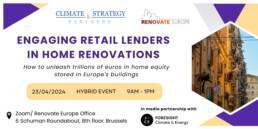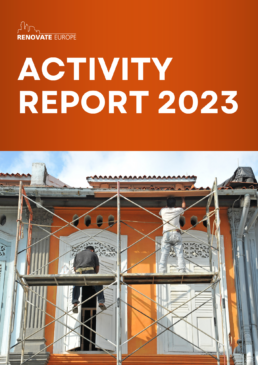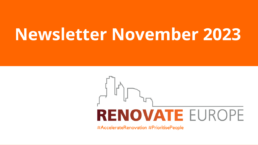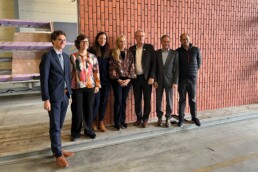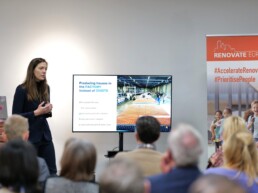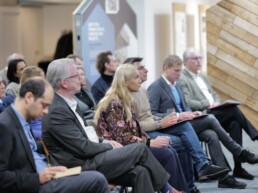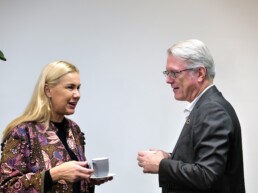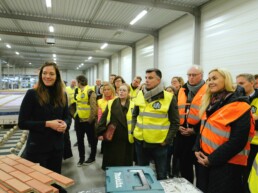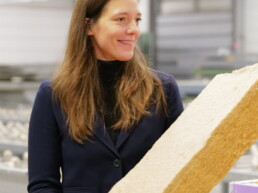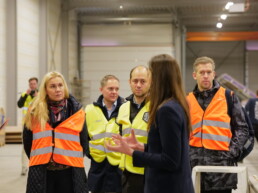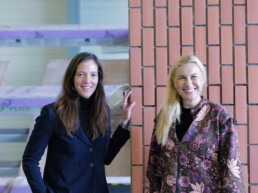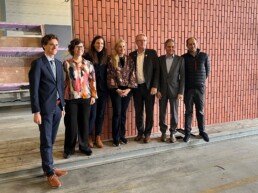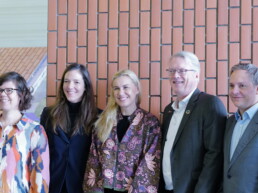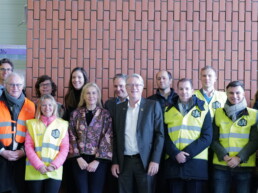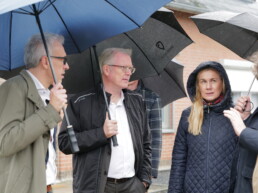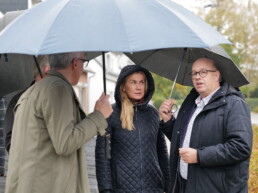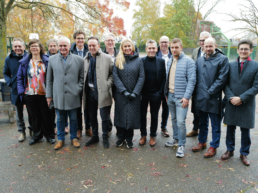Engaging Retail Lenders in Home Renovations
Join us online or in-person in Brussels at Rondpoint Robert Schuman 6!
Europe is in a race to achieve independence from foreign energy sources, alleviate its citizens from rising energy prices, and to meet its ambitious climate targets. Consuming 42% of energy and being responsible for over one third of energy-related GHG emissions, the decarbonisation of the buildings in the EU is essential to achieve this.
How can we identify which buildings to renovate? How can we provide access to low cost, long-term financing for deep renovations across Europe?
Having business relationships with more than 25 million EU customers, mortgage lenders are the single most connected stakeholder group to Europe’s buildings. As of 2022, mortgages accounted for about 80% of the lending to households. Evidently, the mortgage is the most appropriate and widely used financing tool to provide homeowners investment capital and the opportunity simultaneously to upgrade their buildings to make them resilient against energy shocks, more affordable to run and more comfortable and healthy to live in.
In this event, the Renovate Europe Campaign and Climate Strategy (CS) will present the current state of EU buildings’ renovation efforts and the findings of the latest CS report “Engaging Retail Lenders in Home Renovation”, calling for EU mortgage lenders to play a more proactive role in unlocking the trillions of home equity stored in the buildings owned by their clients through the voluntary uptake of the innovative instrument Mortgage Portfolio Standards (MPS). EU policymakers, buildings experts and finance sector stakeholders will then exchange views on these subjects.
There is growing momentum for Mortgage Portfolio Standards as over a third of the top-30 banks in Europe already have in place a form of voluntary MPS, or equivalent. We look forward to a lively discussion on its potential, design and place within Europe’s decarbonisation efforts. Included in the final version of the Energy Performance Building Directive (EPBD) adopted by the EU Parliament in March 12th of this year, Mortgage Portfolio Standards were defined as:
“Mechanisms incentivising mortgage lenders to establish a path to increase the median energy performance of the portfolio of buildings covered by their mortgages towards 2030 and 2050, and to encourage potential clients to make their property more energy-performant along the Union’s decarbonisation ambition and relevant energy targets in the area of energy consumption in buildings, relying on the definition of sustainable economic activities in the EU Taxonomy.”
Agenda
9:30 AM – 9:40 AM Welcome and Introduction
Adrian Joyce, Director of the Renovate Europe Campaign
9:40 AM – 9:45 AM Ministerial Perspectives on EPBD transposition – Short video
Petr Hladík, Minister of the Environment of Czechia
9:45 AM – 10:10 AM Keynote “The Role of Retail Lenders in Buildings Renovation” and Q&A
Peter Sweatman, CEO Climate Strategy & Partners
10:10 AM – 11:15 AM Panel 1 “Frameworks and financial mechanisms to renovate buildings” and Q&A
Moderated by Sean Carroll, Cities & Buildings Editor, FORESIGHT
- Carlos Sanchez Rivero, DG ENER
- Madeline Schneider, PCAF
- Céline Carré, Saint-Gobain
- Murray Birt, DWS
11:15 AM – 11:30 AM Coffee Break
11:30 AM – 12:45 PM Panel 2 “Climate Risks and Mortgage Portfolios”
Moderated by Vanesa Osuna, Secretariat, Net-Zero Banking Alliance (NZBA)
- Ali Erbilgiç, European Banking Authority
- Dominic Keyzer, ING
- Imène Ben Rejeb-Mzah, BNP Paribas
- Tobias Horn, Deutsche Bank
12:35 PM – 12:45 PM Analysis and key takeaways of Panels 1 and 2
Peter Sweatman, CEO Climate Strategy & Partners
12:50 PM – 1:00 PM Concluding remarks
Adrian Joyce, Director of the Renovate Europe Campaign
A New Era for the European Renovation Wave: Sharing Perspectives
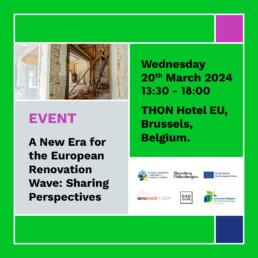
We are excited to join C40 Cities, the Global Covenant of Mayors for Climate & Energy (GCoM), and the Covenant of Mayors Europe in organising this event, A New Era for the European Renovation Wave: Sharing Perspectives, on the 20th of March in Brussels.
Building renovations are key to improving energy efficiency and energy security, lowering energy bills, creating local green jobs, and improving quality of life. Cities play a key role in delivering the benefits of fossil-free and energy-efficient buildings.
Ahead of the European elections, this event will bring together mayors, deputy mayors, business associations, EU policy makers and key stakeholders to take stock of the progress so far and discuss challenges and opportunities for the future regarding building renovations, following also the update of the European climate and energy legislation.
Agenda
13.30 – 14.00 Registration and coffee
14.00 – 14.10 Welcoming remarks
Benjamin Jance, Head of Research and Innovation at Global Covenant of Mayors for Climate & Energy (GCoM)
14.10 – 14.25 Opening remarks by a keynote speaker
Brian Motherway, Head of the Office of Energy Efficiency and Inclusive Transitions, IEA (online)
14.25 – 15.20 What comes next for building renovations in Europe and the role of the cities
Moderator: Marnie McGregor, GCoM
- Nina Neumann, Team leader, Legislative Development and Enforcement, DG ENER, European Commission
- Peter Dermol, Mayor of Velenje, Slovenia
- Ralf Goldmann, Head of Division, Energy Efficiency and Energy Advisory, European Investment Bank
15.20 – 15.45 COFFEE BREAK
15.45 – 16.45 Enhancing cooperation between cities and stakeholders to boost local action on buildings
Moderator: Oliver Rapf, Executive Director, Buildings Performance Institute Europe (BPIE)
- Andrea Tobia Zevi, Deputy Mayor of Rome for Heritage and Housing, Italy
- Britt Berghs, project coordinator ‘Linkeroever (Left Bank)’ Climate Neutral 2030 for the city of Antwerp, Belgium
- Julien Dijol, Director of Policy, Housing Europe
- Walburga Hemetsberger, CEO Solar Power Europe
- David Ducarme, COO and Deputy CEO Knauf Insulation, Partner of the Renovate Europe Campaign
16.45 – 17.00 Concluding remarks
Adrian Joyce, Renovate Europe Campaign
17.00 Cocktail reception
Read our Activity Report 2023
The Renovate Europe 2023 Activity Report is now live!
The Renovate Europe Campaign is the voice for energy renovations. We are committed to creating a platform where our partners can collaborate while bridging the gap between national partners and EU policy makers.
Read it to learn about our Renovate Europe Day in Madrid, our field trip with Commissioner Kadri Simson and her cabinet to renovation sites in Belgium, and the C4E Forum in Bratislava.
Thank you to all of our partners and everyone else who participated in Renovate Europe events last year.
REC Newsletter - November 2023
Welcome to Renovate Europe‘s newsletter highlighting our key actions over the past months!
We were delighted to organise in November a programme for EU Energy Commissioner Kadri Simson and her Cabinet to visit two renovation projects in Belgium and witness EU policy in action. As the negotiations of the Energy Performance of Buildings Directive come to an end, it is worth highlighting the impact EU policy can have on accelerating industrial and innovative approaches to energy renovation, but also the impact it can have on local communities. Read more.
This year, for the first time since 2011, Renovate Europe Day 2023 took place outside of Brussels, and travelled to Madrid for the Spanish Presidency of the EU Council. This conference was a key moment for us to assess progress on energy renovation, especially in the Spanish context, gather inspiration from successful initiatives, and emphasise the paramount importance of an ambitious Buildings Directive for citizens, civil society, industry and the climate. See you next year in Budapest, Hungary! Read more.
Renovate Europe supported Buildings Performance Institute Europe (BPIE) in a remarkable renovation videos project across six EU countries. Take a look at these renovation stories on BPIE’s YouTube channel.
Two new partners have joined the Renovate Europe Campaign in 2023! They are BASF and EPPA. Read what they had to say in the newsletter.
Read the full Newsletter here.
European Commissioner for Energy, Kadri Simson, visits renovation projects in Belgium
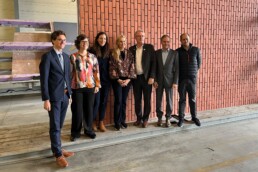
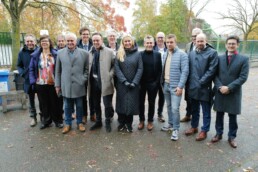
Renovate Europe was delighted to organise a programme for EU Energy Commissioner Kadri Simson and her Cabinet to visit two renovation projects in Belgium on the 10th of November 2023 and witness EU policy in action. As the negotiations of the Energy Performance of Buildings Directive come to an end, it is worth highlighting the impact EU policy can have on accelerating industrial and innovative approaches to energy renovation, but also the impact it can have on local communities.
First Stop: BuildUp Factory, Aarschot
In the morning, we explored the innovative modular approach to energy renovation at the BuildUp Factory. Commissioner Simson witnessed first-hand how this fast-growing startup is reshaping energy renovations with speed and efficiency. Their offsite construction solutions exemplify how European industry can minimise disruptions and maximise energy savings. Digitalisation plays a key part in their process.
In Lille, BuildUp led on the energy renovation of school buildings during the summer break, thus not disturbing the students and teachers in any way. Click here to watch the video.
Second Stop: Gansbeek Residential Area
Our journey continued to Bilzen, where the transformation of the Gansbeek Residential Area showcased a 60% reduction in energy bills for social housing residents. It was work undertaken by Knauf Insulation’s division Knauf Energy Solutions, in partnership with Daikin and Fluvius, for the Wonen in Limburg housing company.
The visit highlighted that energy renovation not only saves energy costs but also substantially improves living comfort.
These visits underscore the vital role of energy efficient buildings for EU citizens, industry, the local economy, and the climate. With the EPBD recast negotiations concluding, we must ensure it provides a long-term, stable framework to guide our industries’ investments in new factories, new solutions and more skilled workers.
We extend our profound thanks to Commissioner Simson for her insightful visit and support. Together, we will continue to advocate for a more sustainable, energy efficient, and competitive Europe.
#AccelerateRenovation #PrioritisePeople
Renovate Europe Day 2023 in Madrid, Spain
Mark your calendar and join us on the 3rd of October in Madrid where the Renovate Europe Day conference will take place this year.
This high-level conference will be the moment to take stock of progress in the Spanish context, take inspiration from good examples on the ground and better understand why an ambitious Buildings Directive is crucial for energy security, climate action, citizens and the industrial competitiveness of Europe.
- Date: Tuesday 3rd October 2023
- Location: Commission Representation in Madrid (Paseo de la Castellana, 46)
- Co-organisers: Renovate España (Green Building Council España GBCe, Confederación Nacional de la Construcción CNC), Ecodes and Climate Action Network (CAN) Europe
- Translation: English/ Spanish translation will be provided throughout


